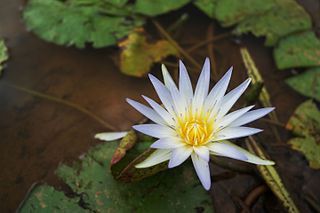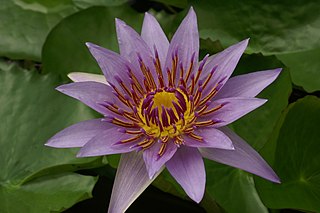This page is based on this
Wikipedia article Text is available under the
CC BY-SA 4.0 license; additional terms may apply.
Images, videos and audio are available under their respective licenses.

Nymphaeaceae is a family of flowering plants, commonly called water lilies. They live as rhizomatous aquatic herbs in temperate and tropical climates around the world. The family contains five genera with about 70 known species. Water lilies are rooted in soil in bodies of water, with leaves and flowers floating on or emergent from the surface. The leaves are round, with a radial notch in Nymphaea and Nuphar, but fully circular in Victoria and Euryale.

In Greek mythology the lotus-eaters, also referred to as the lotophagi or lotophaguses or lotophages, were a race of people living on an island dominated by lotus plants. The lotus fruits and flowers were the primary food of the island and were a narcotic, causing the inhabitants to sleep in peaceful apathy.

Nefertem was, in Egyptian mythology, originally a lotus flower at the creation of the world, who had arisen from the primal waters.
Nefertem represented both the first sunlight and the delightful smell of the Egyptian blue lotus flower, having arisen from the primal waters within an Egyptian blue water-lily, Nymphaea caerulea. Some of the titles of Nefertem were "He Who is Beautiful" and "Water-Lily of the Sun", and a version of the Book of the Dead says:
Rise like Nefertem from the blue water lily, to the nostrils of Ra, and come forth upon the horizon each day.

Nymphaea is a genus of hardy and tender aquatic plants in the family Nymphaeaceae. The genus has a cosmopolitan distribution. Many species are cultivated as ornamental plants, and many cultivars have been bred. Some taxa occur as introduced species where they are not native, and some are weeds. Plants of the genus are known commonly as water lilies, or waterlilies in the United Kingdom. The genus name is from the Greek νυμφαια, nymphaia and the Latin nymphaea, which mean "water lily" and were inspired by the nymphs of Greek and Latin mythology.

Nymphaea caerulea, known primarily as blue lotus, but also blue water lily, and sacred blue lily, is a water lily in the genus Nymphaea. Like other species in the genus, the plant contains the psychoactive alkaloid aporphine. It was known to the Ancient Egyptian civilization.

Nymphaea lotus, the white Egyptian lotus, tiger lotus, white lotus or Egyptian white water-lily, is a flowering plant of the family Nymphaeaceae.
Sacred lotus may refer to:
Nymphaea lotus f. thermalis is a form of Nymphaea lotus in the genus Nymphaea. Whilst some authorities list Nymphaea lotus f. thermalis as being synonymous with N. lotus, others list it as a distinct taxon – further investigation is required to determine its precise classification. The usual habitat for Nymphaea lotus is the Nile Delta, hence Nymphaea lotus f. thermalis's Romanian habitat is unusual.

The Coptic flag was created in 2005 by Coptic activists in different countries to represent Coptic communities both in Egypt and in the Coptic diaspora. It is not recognized by the Coptic Orthodox Church of Alexandria, but many Copts worldwide have adopted it as a symbol of Coptic identity. The Coptic flag has been officially recognized and adopted by the New Zealand Coptic Association and the Free Copts.

Nymphaea mexicana is a species of aquatic plant that is native to the Southern United States and Mexico as far south as Michoacán. Common names include yellow waterlily, Mexican waterlily and banana waterlily.

Nymphaea pubescens, the hairy water lily or pink water-lily, is a species of water lily.
Nymphaea zenkeri, the red tiger lotus, is a flowering plant of the family Nymphaeaceae that grows in various parts of East Africa. This species is known for its brilliant reddish-purple tinted heart-shaped leaves.

Nymphaea colorata is a water lily that is native to tropical East Africa. It was first described by A. Peter in 1928.

Nymphaea nouchali, often known by its synonym Nymphaea stellata, or by common names blue lotus, star lotus, red and blue water lily, blue star water lily or manel flower is a water lily of genus Nymphaea. It is native to southern and eastern parts of Asia, and is the national flower of Sri Lanka and Bangladesh. This species is sometimes considered to include the blue Egyptian lotus Nymphaea caerulea. In the past, taxonomic confusion has occurred, with the name Nymphaea nouchali incorrectly applied to Nymphaea pubescens.

Myricitrin is a plant compound, the 3-O-α-L-rhamnopyranoside of myricetin.

Blue lily may refer to the following plant species:

Coptic nationalism refers to the nationalism of Copts, an ethno-religious group that primarily inhabit the area of modern Egypt, where they are the largest Christian denomination.












